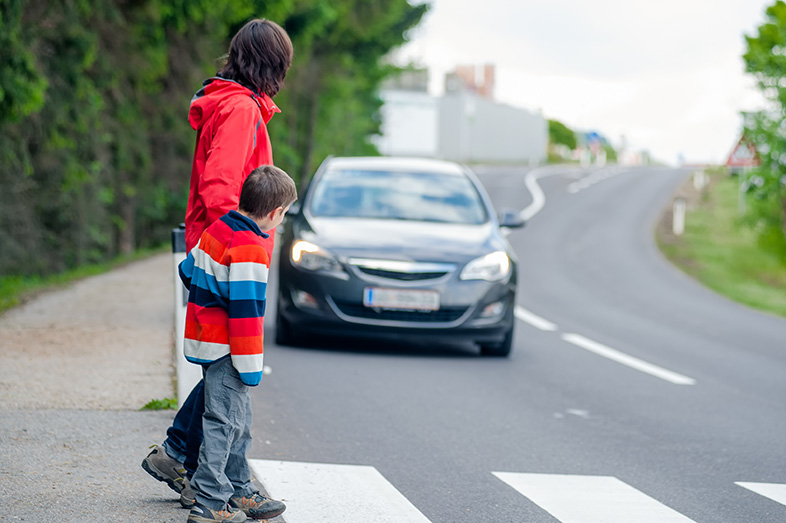With the beginning of a new school year, many towns and cities experience increased pedestrian traffic. Around one in five children under 15 who die in traffic accidents in the U.S. are pedestrians, according to the Centers for Disease Control and Prevention (CDC).
The risks of a severe injury or death in a pedestrian accident exist all year, and pedestrians account for 17 percent of traffic fatalities involving people older than the age of 15 as well.
Here are seven safety tips for avoiding accidents with pedestrians.

1. Stay Alert, Particularly In Areas Where Pedestrians Are Known to Be
“I didn’t even see them.”
This is one of the most common phrases uttered at accident scenes across the U.S., particularly at those involving pedestrians or other vulnerable roadway users, such as bicyclists or motorcyclists.
As it turns out, this statement is not always just a convenient excuse for why an accident occurred. In many cases, the driver does not see the pedestrian due to the phenomenon known as inattentional blindness.
This is not a medical condition but rather the way the brain responds to and processes information, focusing on the largest or the most important details while failing to recognize more minor details in the environment.
In a chaotic scene, such as an intersection during the morning rush hour in Eau Claire, the driver can be focused on more considerable hazards on the roadway, such as large or fast-moving vehicles, as well as other aspects of driving safely. In doing so, they fail to notice the smaller, slower-moving, less-threatening pedestrian crossing the roadway.
Drivers should remember that pedestrians can be found anywhere. Still, they should be particularly cautious in areas such as school zones, roadways surrounding city parks, neighborhoods where children live and play, and parking lots.
2. Yield to Pedestrians at Crosswalks
Most drivers understand that they should yield when a pedestrian with a walk signal has entered a marked crosswalk. However, they fail to realize that every intersection is considered a crosswalk, even if there are no markings or traffic signals that designate it as such.
You should stop when you see someone step into the roadway and provide them with ample opportunity to get completely across your side of the road before continuing on your journey. Do not attempt to squeeze around the pedestrian or cut them off in the crosswalk, as these behaviors can lead to an accident. Nearly a quarter of all pedestrian accidents occur at an intersection.
According to the National Safety Council, pedestrians are most likely to die in collisions involving motor vehicles during the nighttime hours. While there are several reasons for this, the biggest reason is that pedestrians are hard to see. Being alert when approaching crosswalks is essential, particularly in low-visibility conditions.
3. Do Not Pass a Vehicle Stopped at a Crosswalk
If a vehicle is stopped at a crosswalk, the safest bet is to assume a pedestrian is crossing in front of them. This is true even if you are unable to see the pedestrian. In any state in the nation, passing in a crosswalk is forbidden. This will result in a citation, or worse: a collision with a pedestrian resulting from a traffic violation. The driver will typically be held liable for expenses and impacts incurred by the pedestrian and/or their family due to the injury or death.
4. Never Pass a Stopped Bus
Just as nearly every state and municipality in the country requires drivers to stop for pedestrians in the crosswalk, they also prohibit drivers from passing school buses that are stopped and have their stop arm extended. The reason for the bus to extend its stop arm is to warn drivers approaching from either side of the roadway that a passenger is either entering or exiting the bus.
The passenger—generally a child on the school bus—often needs to cross the road to get home or to get to the bus stop from their home. Additionally, they can have parents or older siblings who have entered the roadway to escort the child safely.
Drivers should stop at least 20 feet from the school bus in either direction when it has its red lights flashing, and its stop arm extended. After the lights have stopped flashing and the stop arm has been disengaged, the driver should still proceed cautiously in the area, looking for children on the side of the road who intend to cross.
5. Watch Your Speed
Speeding is one of the most common causes of any type of traffic accident, including accidents that involve pedestrians.
The reasons that driving faster than the posted speed limit or too fast for the traffic and weather conditions of the road is dangerous to pedestrians include:
- The time the driver has to perceive a hazard on the road and brake decreases. If a pedestrian unexpectedly enters the road, they might not see them until too late.
- The distance the car will travel after the driver brakes increases. Stopping a vehicle is not instantaneous. The brakes take some time to pull the vehicle’s weight to a complete stop. The heavier the car, the farther it will travel after the brakes have been applied. Slippery or icy road conditions can also increase stopping distance. In the case of a pedestrian accident, even if the speeding driver can see the pedestrian before colliding and react by slamming on the brakes, the vehicle will continue to travel forward for some distance.
- Pedestrians and others will have difficulty determining a safe gap in traffic in which to enter the roadway. Many states allow pedestrians to cross outside the crosswalk, particularly if there is a considerable distance between intersections. However, in doing so, the pedestrian must ensure there is a sufficient break in traffic to cross. A collision can occur if a car travels faster than the pedestrian anticipated.
- Excessive speed increases the force of the collision. When a collision occurs, it will likely result in more severe injuries.
6. Do Not Drive Drunk
The CDC notes that nearly half of all pedestrian fatalities involve either a drunk driver or a drunk pedestrian. Unfortunately, many drivers believe they are safe to drive if they do not reach the legal impairment limit for most adult drivers in Wisconsin and Minnesota of 0.08 grams of alcohol per deciliter of blood. However, the effects of alcohol impairment do not start when a drinker reaches the legal impairment limit but when the driver takes their first drink.
At 0.02 blood alcohol content (BAC)—the equivalent of about one drink in an hour for most people—the driver is likely to experience effects such as a decline in the visual functions needed to track moving targets and properly surveil the roadway. At 0.05 BAC—which can be reached at two to three drinks in one hour—the driver is likely experiencing reduced coordination, difficulty steering, and a slowed response to emergency driving situations.
At the legal impairment limit— which is commonly reached upon consuming around four alcoholic drinks in an hour—the driver is generally suffering significant impacts to their concentration, as well as short-term memory loss, difficulty controlling the vehicle’s speed, deficits in their ability to process information, such as changing traffic signals, and impaired perception.
At 0.10 BAC, they will likely lose the ability to maintain lane position or brake effectively.
None of these deficits are conducive to avoiding an accident with a pedestrian.
7. Eliminate Distractions
Like speeding and drunk driving, distracted driving is another of the leading causes of all types of traffic accidents, including those involving pedestrians.
A driver distraction involves anything that causes the driver to take their:
- Hands from the wheel. This manual distraction includes activities such as eating, drinking, smoking, adjusting vehicle or stereo controls, or reaching for something in the passenger seat, back seat, or the vehicle’s floor.
- Eyes off the road. This is a visual distraction; examples include looking at other people or vehicles on the roadway, looking at a GPS, studying billboards, or even communicating with pets or children in the backseat.
- Mind off of driving safely. This is known as a cognitive distraction. Examples include thinking about work while driving, daydreaming, or visiting with passengers.
Texting while driving has garnered much attention as a dangerous driver distraction in recent years, resulting in many states passing laws prohibiting the behavior. Texting and driving is dangerous because it simultaneously presents all three types of driving distractions. The driver takes their hand from the wheel, takes their eyes from the road, and focuses their attention on this form of communication rather than on the task of driving safely.
Wisconsin’s texting and driving laws include the following provisions:
- Drivers with an instructional or probationary permit are prohibited from using hand-held devices while driving.
- All drivers are prohibited from using a hand-held device for any reason in a construction zone except when they use their phone to report an emergency.
- Texting and driving is prohibited for all drivers.
In Minnesota, where distracted driving causes one in nine traffic accidents, the law prohibits drivers from reading, sending texts or emails, or accessing the internet. This includes time sitting at a stop sign or stop light.
What Should You Do if a Pedestrian Accident Injures You?
Suppose you have been injured in a pedestrian accident caused by a negligent driver. In that case, you have the right to seek compensation through a personal injury claim against the at-fault driver’s liability insurance policy. Suppose the insurance provider fails to fairly compensate you for the expenses and impacts of your injury.
In that case, you can also file your claim as a personal injury lawsuit to have a judge or jury determine if you have proven liability and owed compensation. To use the court process to seek compensation on your claim, you must file it within the statute of limitations, a deadline set by state laws.
An experienced personal injury attorney has a crucial role in the success of your claim, offering services such as:
- An investigation of the accident to determine who was liable and what insurance resources they have that can be accessed to compensate you.
- The establishment of a value to your claim based on the expenses you incurred as a result of your injury, the severity of the damage, and the amount of insurance available to compensate you. Most insurance policies limit how much the provider will pay on a claim.
- Managing communication with the at-fault party’s insurer to protect the value of your claim from being degraded as a result of common insurance company tactics and to keep the conversation focused on negotiating a fair settlement for the expenses and impacts of your injury.
- Filing the claim in court within the statute of limitations to protect your right to use the court process.
- Litigation services, including the preparation of evidence exhibits, deposing witnesses and examining them at trial, and delivery of opening and closing arguments.
- Collecting your compensation upon the favorable resolution of your claim through a negotiated settlement or a court award.

Were you injured in a pedestrian accident? Let a personal injury attorney answer the questions you have about your case and explain the personal injury claims process in greater detail. Contact a pedestrian accident attorney today for your free case evaluation.